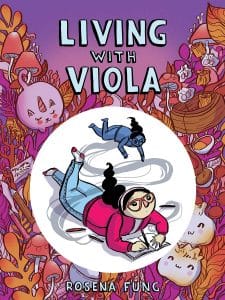It’s Livy’s first day of sixth grade at her new school and Livy is understandably apprehensive. There are worries about new friends, about fitting in, about making her parents (who have sacrificed to send their only daughter to a school in a better district) proud. But Livy has more than nerves; following Livy to school is Viola, Livy’s anxiety brought to life as a violet-hued shadow that constantly rattles and second-guesses Livy’s thoughts and actions.
Living with Viola, a graphic novel by Rosena Fung, tells the story of Olivia Siu Leen Tong, a young Canadian who, like Fung, has anxiety and whose parents immigrated from Hong Kong to Canada. In her author’s note, Fung writes that Olivia was very much inspired by Fung’s own experiences—both as an outsider and daughter of immigrants as well as her struggle with mental health—and by her passion for reading and drawing.

Livy’s first day of school doesn’t go according to plan. When Olivia’s anxiety takes over during roll call her teacher comments:
“Looks like we’ve got a dreamer here. You can sit down, Olivia. But please pay more attention. I called your name three times.”
At lunch time, Livy opens her Thermos to the sound of another kid asking: “What’s that smell?”
When Livy returns home, she finds comfort in making dumplings with her parents and in reading and drawing. Determined that her second day of school be more successful than her first, Livy arrives more confident with a new headband and freshly sharpened pencils. But Viola appears again when Livy sees gym class on her schedule.
Viola looms: “Heh heh heh welcome in, loser.”
While Livy begins to settle into her new school (her talent in art class, for example, makes her teacher see her in a different light), Viola continues to make her presence felt both in and out of school. But while Livy grapples with Viola, she also feels it’s a subject she can’t broach with her parents. Early in the graphic novel, Livy’s extended family gathers for dim sum where, in hushed tones, the family mentions an older cousin with mental health struggles, his situation being described as “shameful”. Viola lurks and continues to influence Livy until Livy finally asks for help.

Fung’s bright artwork brings Livy’s story to life. Mostly told in a palette of warm colors that complement the purple-ish hue of Viola, Fung also brings in lighter elements—in one scene, for example, dumplings, something that Livy loves, chase Viola away. The idea to present Livy’s anxiety as a character in the book helps to illustrate the ever-presence of anxiety as well as the impact it has on every element of Livy’s life.
Intertwined in the discussions of mental health are explorations of Livy’s heritage. In addition to her anxiety, Livy feels different to many of her classmates and her desire to belong is strong. Livy is asked to explain her background to some of the friends (another character with Chinese heritage remarks: “My parents were born here. They don’t even eat white rice. They read it’s bad for you.”). And while Livy is, perhaps like many middle schoolers, embarrassed by her parents, it is when she speaks with her father that Livy seems to better understand her parents’ perspective.
“People treat you differently when you are an immigrant. They aren’t always nice to you. They tell you to ‘go home’ or make fun of the way you talk. Even when you try your best.”
Accompanied by a glossary of Cantonese terms, Fung successfully strikes a balance in discussing issues of mental health, belonging and cultural differences with engaging illustrations and an interesting story.


You must be logged in to post a comment.